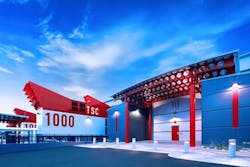One of the world’s largest cloud campuses is getting even bigger. Switch has just opened Las Vegas 10, the newest data center on its Core Campus (SUPERNAP) campus.
The new facility supports 350,000 square feet of data center space, bringing the Switch Las Vegas campus (which was already the number one cloud campus in our rating of the world’s Top 10 cloud campuses) to more than 2 million square feet of data center space and 315 megawatts of critical power.
“The Internet doesn’t stop growing and neither does Switch,” said Lesley McVay, Switch Executive Vice President of Data Center Services. “We expect to continue to meet the incredible growth demands of our clients, not only at The Core Campus in Las Vegas, but across the country.”
Over the past two years, Switch has been growing in new markets, opening new U.S. data center campuses in Reno, Nevada and Grand Rapids, Michigan, and international campuses in Milan, Italy and Bangkok, Thailand. The company just announced a new campus near Atlanta. Upon completion, these projects will bring more than 10 million square feet of data center space online.
Las Vegas: Home to Data Center Innovation
Switch may have global ambitions, but Las Vegas is where the company built its business and reputation for innovation. That’s where founder and CEO Rob Roy pioneered new ideas in cooling and aisle containment, which Roy developed as he filled six smaller data centers in Las Vegas between 2000 and 2006.
All that innovation came together in the original SuperNAP (now Las Vegas 7), a 400,000 square foot data center that was notable for its size and ability to cool high-density workloads. Here’s
The Switch design was further refined in a global design template that Roy created for Las Vegas 8, which was completed in 2014. Switch uses pre-fabricated modular components to create a data center that can operate effectively in any climate. This approach, which Roy calls the “end game” for his design vision, was used to create Las Vegas 9, which was completed in 2015. Here’s a look at the design and scale of the Las Vegas CORE campus.
The Las Vegas 10 data center features a Switch MOD 250 (Modularly Optimized Design), and was fueled by strong demand for colocation services from both existing and new clients, the company said. Switch has more than 1,000 customers, including Amazon Web Services, eBay, Marvel, Shutterfly, FOX, Amgen, Intuit, DreamWorks, Intel, Machine Zone, Boeing, Warner Brothers, NASA, Verizon and many hundreds more.
Almost 1,000 construction workers, 85 percent of whom are Nevadans, have been employed building Las Vegas 10 over the past eight months.
Greening Hyperscale Colo
Las Vegas 10 will use 100 percent renewable energy, a policy Switch adopts for all of its data centers. Switch is the first multi-tenant data center provider to receive a perfect score in the six-year history of Greenpeace’s report on IT sustainability.
The company’s expansion is enabled by a global design template, which uses pre-fabricated modular components to create a data center that can operate effectively in any climate. Switch founder and CEO Rob Roy describes this design, introduced at SUPERNAP 8 in 2014, as the “end game” for his vision for a versatile, scalable design.
Switch is creating a network of four U.S. “PRIME” data center campuses:
- Las Vegas (CORE Campus) serves as a hub for Los Angeles, Phoenix and the rest of the Southwestern United States
- Tahoe Reno (Citadel Campus) serves as a hub for San Francisco, Silicon Valley and the rest of the Northwestern United States
- Grand Rapids (Pyramid Campus) serves as a hub for Chicago, New York and the rest of the Northeastern United States
- Atlanta (The Keep) will serve as a hub for Ashburn, Miami and the rest of the Southeastern United States
Switch said Las Vegas 10 will meet its new Tier 5 reliability standard. The Las Vegas facilities had previously been certified as Tier IV for both design and construction, the highest rating available from the Uptime Institute. Switch recently introduced its own proprietary rating system, saying the Uptime Tiers failed to consider the full breadth of issues that differentiate data centers, including connectivity, security and use of renewable energy.
[clickToTweet tweet=”Lesley McVay: The Internet doesn’t stop growing and neither does Switch.” quote=”Lesley McVay: The Internet doesn’t stop growing and neither does Switch.”]
In developing its new metric, Switch worked with several of the original authors of the Uptime Institute Tier system.
“The original standards were created for enterprise data centers,” said Hank Seader, the principal author and co-creator of the Uptime Institute standards and former managing principal of the Uptime Institute. “The data center options available to the industry have expanded, and so to be relevant, the standards need to be expanded as well.”
Uptime said its standards have the ability to evolve.
“Because every data center is different, with varying complexities and issues based on variables like local characteristics or build parameters, Uptime Institute’s Tier Standards are designed to be highly flexible in their approach, avoiding the need to be rewritten as the topology expands,” said Lee Kirby, President of Uptime Institute.






